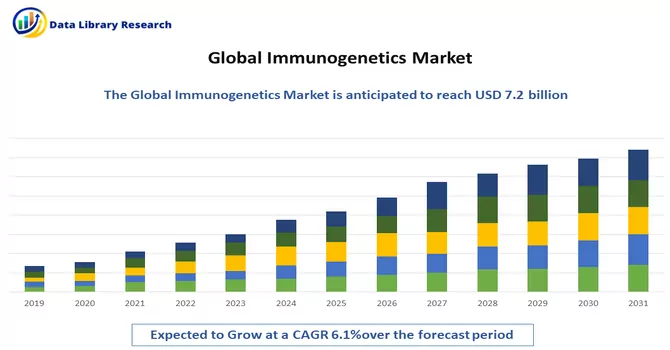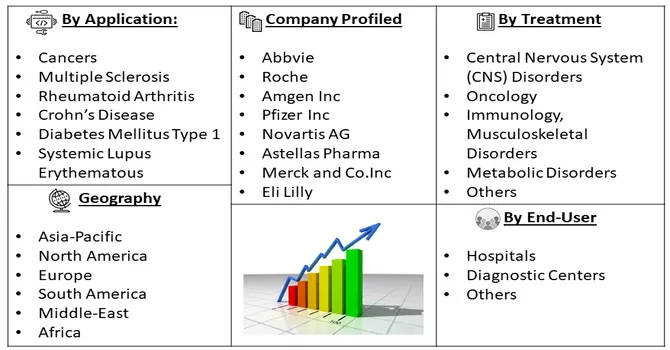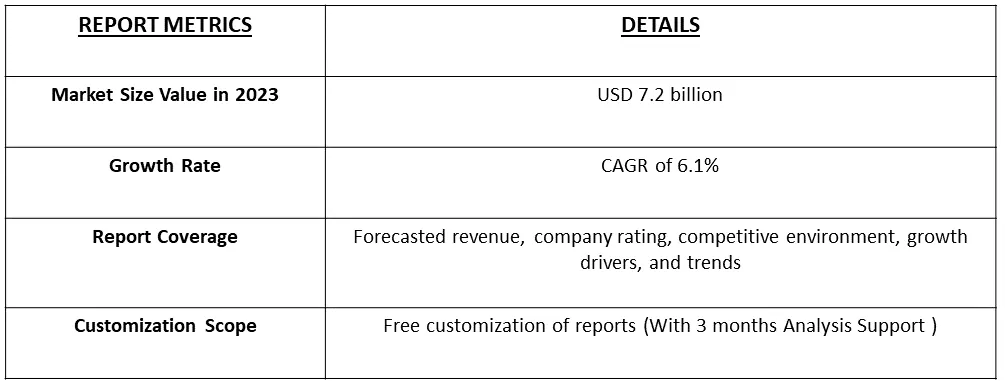The global immunogenetics market is currently valued at USD 7.2 billion in the year 2023 and is expected to register a CAGR of 6.1% in the above-mentioned forecast period, 2024-2031.

Get Complete Analysis Of The Report - Download Free Sample PDF
The major factors attributing to the growth of the immunotherapy drugs market are the rising adoption of targeted therapy over traditional therapy, the emergence of biosimilars, the rising prevalence of chronic diseases and lifestyle disorders, and the rising demand for monoclonal antibodies.
Immunogenetics or immunogenetics is the branch of Medical Immunology and Medical Genetics that explores the relationship between the immune system and genetics. Autoimmune diseases, such as type 1 diabetes, are complex genetic traits that result from defects in the immune system.
Factors such as growing research collaborations, increasing number of research laboratories, and growing direct and indirect investments in research and development (R&D) by pharmaceutical and biotechnology companies will also support the market's growth in the coming years.
Segmentation:
The global Immunogenetics Market is Segmented
By Application:
Geography

For Detailed Market Segmentation - Download Free Sample PDF
Drivers:
In January 2022, GlaxoSmithKline plc and Vir Biotechnology partnered with the United States government to purchase an additional supply of Sotrovimab for the early treatment of COVID-19. Such partnerships with government organizations for the supply of immunotherapy drugs are also expected to drive the growth of the market. Globally, there has been a continuous rise in the prevalence of several chronic diseases, which, in several cases, need immune-based therapies.
Major chronic diseases include cancer, kidney failure, autoimmune and inflammatory diseases, and heart diseases. For instance, the report published by Public Health of England in March 2020 mentioned that approximately 1 in 5 adults over 45 years had osteoarthritis of the knee, and 1 in 9 adults had osteoarthritis of the hip. Thus, the incidence of chronic diseases is expected to drive the growth of the market. Additionally, according to the GLOBOCAN 2020 data, globally, in 2020, the total number of new cancer cases was found to be 9,227,484, indicating that it had risen to 19.3 million cases and 10 million cancer deaths in 2020. Lung cancer and prostate cancer are the most common among men, accounting for nearly one-third of all male cancers. Such an incidence of cancers among the global population is expected to drive the growth of the market.
Immunogenetics Market Restraints Stringent Rules and Regulations.
The stringent rules and regulations are essential to maintain the integrity of research and protect patient rights, they can also present challenges and barriers in the global immunogenetics market. Immunogenetics involves the study of genetic variations related to the immune system and its role in diseases. Any diagnostic tests, therapies, or drugs developed in this field must undergo rigorous testing and evaluation to meet regulatory standards. Regulatory agencies such as the FDA in the United States and the EMA in Europe have specific guidelines that must be adhered to. Meeting these regulatory requirements can be time-consuming and costly, affecting the pace of product development. Thus, may slow down the growth of the studied market.
COVID-19 had a positive impact on the immunotherapy drugs market as the sudden outbreak of the pandemic increased the demand for immunotherapy drugs for the treatment of COVID-19 owing to their safety and efficacy. For instance, in January 2021 the article "Real-world effectiveness and tolerability of monoclonal antibody therapy for ambulatory patients with early COVID-19" reported that monoclonal antibody treatment of high-risk ambulatory patients with early COVID-19 was well tolerated and likely effective at preventing the need for subsequent emergency department or hospital care.
Furthermore, the rise in immunotherapy product approvals by the regulatory authorities was also expected to boost the growth of the market. For instance, in November 2020, the United States Food and Drug Administration issued an emergency use authorization for monoclonal antibodies (Casirivimab and imdevimab) to be administered together for the treatment of mild to moderate COVID-19 in adults and pediatric patients with positive results of direct SARS-CoV-2. Thus, COVID-19 had a pronounced impact on the growth of the market
Cancer is Expected to Hold a Significant Market Share in the Therapy Area Segment Over the Forecast Period
Cancer is an abnormal growth of the cells in the body. There are more than 100 different types of cancer. According to the GLOBOCAN data, in 2020, there were around 2,261,419 (11.7%) new breast cancer cases, 2,206,771 (11.4%) new lung cancer cases, and 1,931,590 (10%) new colorectum cancer cases. Breast cancer represents 1 in 4 cancers diagnosed among women globally. Colorectal, lung, cervical, and thyroid cancers are also common among women. This cancer incidence is expected to rise in the coming years, helping the market grow owing to the demand for effective treatments such as immunotherapy drugs.
There are several types of immunotherapies used for the treatment of cancer. Some immunotherapies include immune checkpoint inhibitors, T-cell cell transfer, cancer vaccines, and immune system modulators. These therapies are used for many types of cancer and their advanced stages. Some of the popular immunotherapy drugs include Rituxan, Yervoy, Adcetris, and Zevalin.
The growth of immunotherapies in developed markets is high, due to increased R&D, with better government policies for supporting clinical trials through findings and campaigns to raise awareness regarding several kinds of cancer.
For instance, in November 2021 Novartis Pharmaceuticals completed phase 2 trials in breast cancer in the United States, United Kingdom, Argentina, Australia, Belgium, and other countries. Such trials can lead to the introduction of new products in the market and thus propel the growth of the market segment.
Thus, the factors mentioned above are expected to show significant growth over the forecast period.
North America Dominates the Market and it is expected to do the Same Over the Forecast Period
North America is expected to have a significant market share throughout the forecast period. This is due to the increasing incidence of cancers, rising geriatric population, growing preference, and adoption rate of immunotherapy rates across the region. People with cancer are at higher risk of infection with the severe acute respiratory syndrome coronavirus 2 (SARS-2-CoV) virus that causes COVID-19. Thus, researchers are in the development of effective therapeutics for COVID-19.
For instance, the clinical trials. gov published in 2020, that the Canadian Cancer Trials Group is conducting a phase III clinical trial to determine if immunization with IMM-101 will reduce the incidence of severe respiratory and COVID-19 infections in cancer patients. The trial started in June 2020 and is expected to be completed in December 2022. According to the estimates of the Globocan, in 2020, there were around 2,556,862 new cancer cases diagnosed in the United States. The most common cancers in the United States are breast cancer, lung cancer, prostate cancer, colorectum cancer, bladder cancer, and skin cancer. Also, The data published by the American Cancer Society in 2022 mentioned that a total of 1.9 million new cancer cases are expected to occur in the United States in 2022.

Get Complete Analysis Of The Report - Download Free Sample PDF
Competative Landscape:
Recent Developments:
1) In January 2022, VirBiotechnology expanded its partnership with Bill & Malinda Gates Foundation to include the advancement of innovative platform technologies in the development of immunotherapy treatments for HIV and the prevention of malaria.
2) In January 2022, Pfizer Inc. received the United States Food and Drugs Administration approval of CIBINQO (abrocitinib), an oral treatment, Janus kinase 1 inhibitor for the treatment of adults living with refractory, moderate-to-severe atopic dermatitis.
Q1. How big is the Immunogenetics Market ?
The global immunogenetics market is currently valued at USD USD 7.2 billion.
Q2. What is the Growth Rate of the Immunogenetics Market?
Immunogenetics Market is expected to register a CAGR of 6.1% in the above-mentioned forecast period.
Q3. Which region has the largest share of the Immunogenetics Market? What are the largest region's market size and growth rate?
North America has the largest share of the market . For detailed insights on the largest region's market size and growth rate request a sample here
Q4. Who are the key players in Immunogenetics Market?
Some key players operating in the market include Abbvie, Roche, Amgen Inc and Pfizer Inc.
Data Library Research are conducted by industry experts who offer insight on industry structure, market segmentations technology assessment and competitive landscape (CL), and penetration, as well as on emerging trends. Their analysis is based on primary interviews (~ 80%) and secondary research (~ 20%) as well as years of professional expertise in their respective industries. Adding to this, by analysing historical trends and current market positions, our analysts predict where the market will be headed for the next five years. Furthermore, the varying trends of segment & categories geographically presented are also studied and the estimated based on the primary & secondary research.
In this particular report from the supply side Data Library Research has conducted primary surveys (interviews) with the key level executives (VP, CEO’s, Marketing Director, Business Development Manager and SOFT) of the companies that active & prominent as well as the midsized organization
FIGURE 1: DLR RESEARH PROCESS

Extensive primary research was conducted to gain a deeper insight of the market and industry performance. The analysis is based on both primary and secondary research as well as years of professional expertise in the respective industries.
In addition to analysing current and historical trends, our analysts predict where the market is headed over the next five years.
It varies by segment for these categories geographically presented in the list of market tables. Speaking about this particular report we have conducted primary surveys (interviews) with the key level executives (VP, CEO’s, Marketing Director, Business Development Manager and many more) of the major players active in the market.
Secondary ResearchSecondary research was mainly used to collect and identify information useful for the extensive, technical, market-oriented, and Friend’s study of the Global Extra Neutral Alcohol. It was also used to obtain key information about major players, market classification and segmentation according to the industry trends, geographical markets, and developments related to the market and technology perspectives. For this study, analysts have gathered information from various credible sources, such as annual reports, sec filings, journals, white papers, SOFT presentations, and company web sites.
Market Size EstimationBoth, top-down and bottom-up approaches were used to estimate and validate the size of the Global market and to estimate the size of various other dependent submarkets in the overall Extra Neutral Alcohol. The key players in the market were identified through secondary research and their market contributions in the respective geographies were determined through primary and secondary research.
Forecast Model
